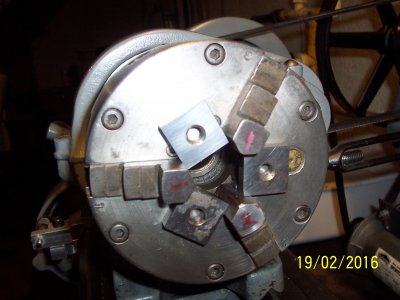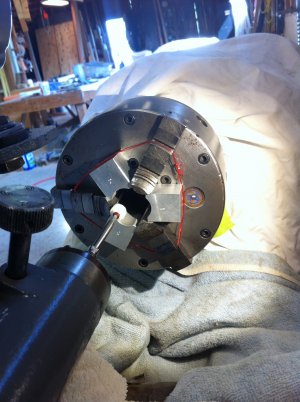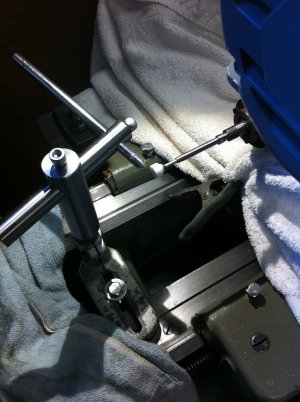Hi all,
I have an old Buck adjust-tru chuck that has bell mouthed one piece jaws. I am planning on grinding the jaws with a tool post grinder and I am trying to create a way to preload the jaws so they are in compression when I do the grinding. My idea is to machine a .250" hole in the flat of each jaw. I will insert a .250" dowel pin so that it sticks up above the surface about 1/4". I will fabricate a 1/4" thick "washer" so that I can tighten the jaws against the outside diameter, with the inside diameter large enough to give clearance for the grinding operation. I set a jaw into my mill ( Clausing 8520) and tried using a .250 carbide 2 flute center cutting end mill. Spindle speed 600. Not able to cut. So I installed a smaller diameter end mill, increased the spindle speed and still no luck. I am thinking that I should drill a pilot hole first and finish with an end mill to the correct diameter. Any thoughts on what kind of drill bit would work or any other ideas?
Thanks,
David
I have an old Buck adjust-tru chuck that has bell mouthed one piece jaws. I am planning on grinding the jaws with a tool post grinder and I am trying to create a way to preload the jaws so they are in compression when I do the grinding. My idea is to machine a .250" hole in the flat of each jaw. I will insert a .250" dowel pin so that it sticks up above the surface about 1/4". I will fabricate a 1/4" thick "washer" so that I can tighten the jaws against the outside diameter, with the inside diameter large enough to give clearance for the grinding operation. I set a jaw into my mill ( Clausing 8520) and tried using a .250 carbide 2 flute center cutting end mill. Spindle speed 600. Not able to cut. So I installed a smaller diameter end mill, increased the spindle speed and still no luck. I am thinking that I should drill a pilot hole first and finish with an end mill to the correct diameter. Any thoughts on what kind of drill bit would work or any other ideas?
Thanks,
David




